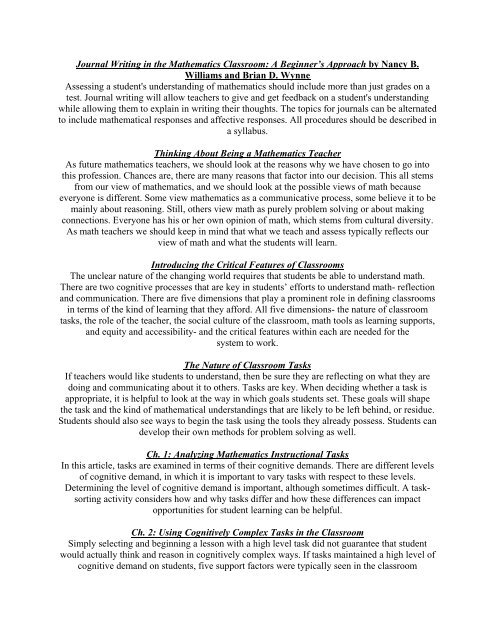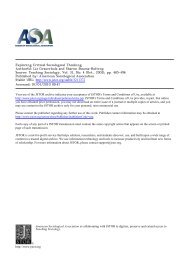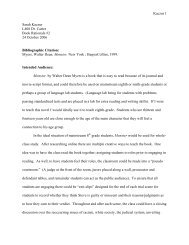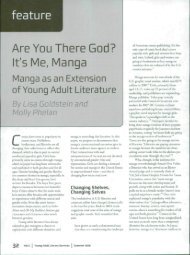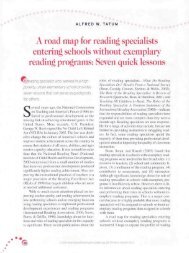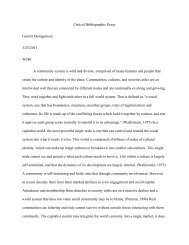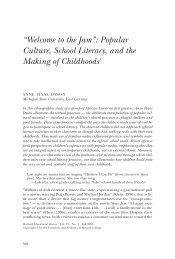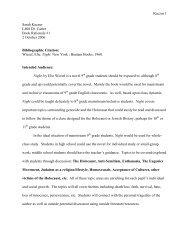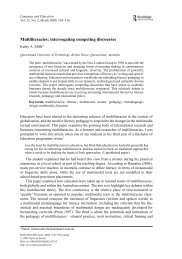Journal Writing in the Mathematics Classroom: A ... - Oncourse
Journal Writing in the Mathematics Classroom: A ... - Oncourse
Journal Writing in the Mathematics Classroom: A ... - Oncourse
Create successful ePaper yourself
Turn your PDF publications into a flip-book with our unique Google optimized e-Paper software.
<strong>Journal</strong> <strong>Writ<strong>in</strong>g</strong> <strong>in</strong> <strong>the</strong> Ma<strong>the</strong>matics <strong>Classroom</strong>: A Beg<strong>in</strong>ner’s Approach by Nancy B.Williams and Brian D. WynneAssess<strong>in</strong>g a student's understand<strong>in</strong>g of ma<strong>the</strong>matics should <strong>in</strong>clude more than just grades on atest. <strong>Journal</strong> writ<strong>in</strong>g will allow teachers to give and get feedback on a student's understand<strong>in</strong>gwhile allow<strong>in</strong>g <strong>the</strong>m to expla<strong>in</strong> <strong>in</strong> writ<strong>in</strong>g <strong>the</strong>ir thoughts. The topics for journals can be alternatedto <strong>in</strong>clude ma<strong>the</strong>matical responses and affective responses. All procedures should be described <strong>in</strong>a syllabus.Th<strong>in</strong>k<strong>in</strong>g About Be<strong>in</strong>g a Ma<strong>the</strong>matics TeacherAs future ma<strong>the</strong>matics teachers, we should look at <strong>the</strong> reasons why we have chosen to go <strong>in</strong>tothis profession. Chances are, <strong>the</strong>re are many reasons that factor <strong>in</strong>to our decision. This all stemsfrom our view of ma<strong>the</strong>matics, and we should look at <strong>the</strong> possible views of math becauseeveryone is different. Some view ma<strong>the</strong>matics as a communicative process, some believe it to bema<strong>in</strong>ly about reason<strong>in</strong>g. Still, o<strong>the</strong>rs view math as purely problem solv<strong>in</strong>g or about mak<strong>in</strong>gconnections. Everyone has his or her own op<strong>in</strong>ion of math, which stems from cultural diversity.As math teachers we should keep <strong>in</strong> m<strong>in</strong>d that what we teach and assess typically reflects ourview of math and what <strong>the</strong> students will learn.Introduc<strong>in</strong>g <strong>the</strong> Critical Features of <strong>Classroom</strong>sThe unclear nature of <strong>the</strong> chang<strong>in</strong>g world requires that students be able to understand math.There are two cognitive processes that are key <strong>in</strong> students’ efforts to understand math- reflectionand communication. There are five dimensions that play a prom<strong>in</strong>ent role <strong>in</strong> def<strong>in</strong><strong>in</strong>g classrooms<strong>in</strong> terms of <strong>the</strong> k<strong>in</strong>d of learn<strong>in</strong>g that <strong>the</strong>y afford. All five dimensions- <strong>the</strong> nature of classroomtasks, <strong>the</strong> role of <strong>the</strong> teacher, <strong>the</strong> social culture of <strong>the</strong> classroom, math tools as learn<strong>in</strong>g supports,and equity and accessibility- and <strong>the</strong> critical features with<strong>in</strong> each are needed for <strong>the</strong>system to work.The Nature of <strong>Classroom</strong> TasksIf teachers would like students to understand, <strong>the</strong>n be sure <strong>the</strong>y are reflect<strong>in</strong>g on what <strong>the</strong>y aredo<strong>in</strong>g and communicat<strong>in</strong>g about it to o<strong>the</strong>rs. Tasks are key. When decid<strong>in</strong>g whe<strong>the</strong>r a task isappropriate, it is helpful to look at <strong>the</strong> way <strong>in</strong> which goals students set. These goals will shape<strong>the</strong> task and <strong>the</strong> k<strong>in</strong>d of ma<strong>the</strong>matical understand<strong>in</strong>gs that are likely to be left beh<strong>in</strong>d, or residue.Students should also see ways to beg<strong>in</strong> <strong>the</strong> task us<strong>in</strong>g <strong>the</strong> tools <strong>the</strong>y already possess. Students candevelop <strong>the</strong>ir own methods for problem solv<strong>in</strong>g as well.Ch. 1: Analyz<strong>in</strong>g Ma<strong>the</strong>matics Instructional TasksIn this article, tasks are exam<strong>in</strong>ed <strong>in</strong> terms of <strong>the</strong>ir cognitive demands. There are different levelsof cognitive demand, <strong>in</strong> which it is important to vary tasks with respect to <strong>the</strong>se levels.Determ<strong>in</strong><strong>in</strong>g <strong>the</strong> level of cognitive demand is important, although sometimes difficult. A tasksort<strong>in</strong>gactivity considers how and why tasks differ and how <strong>the</strong>se differences can impactopportunities for student learn<strong>in</strong>g can be helpful.Ch. 2: Us<strong>in</strong>g Cognitively Complex Tasks <strong>in</strong> <strong>the</strong> <strong>Classroom</strong>Simply select<strong>in</strong>g and beg<strong>in</strong>n<strong>in</strong>g a lesson with a high level task did not guarantee that studentwould actually th<strong>in</strong>k and reason <strong>in</strong> cognitively complex ways. If tasks ma<strong>in</strong>ta<strong>in</strong>ed a high level ofcognitive demand on students, five support factors were typically seen <strong>in</strong> <strong>the</strong> classroom
environment. Tasks that decl<strong>in</strong>ed <strong>in</strong> <strong>the</strong> level of cognitive demand, <strong>the</strong> tasks decl<strong>in</strong>ed <strong>in</strong>toprocedures without connection to mean<strong>in</strong>g, unsystematic exploration ornonma<strong>the</strong>matical activity.Ch. 1 and 2 of Pr<strong>in</strong>ciples and Standards for School Ma<strong>the</strong>matics by NCTMDecisions made by teachers, school adm<strong>in</strong>istrators and o<strong>the</strong>r education professionals about <strong>the</strong>content and character of school ma<strong>the</strong>matics have important consequences both for students andfor society. The Pr<strong>in</strong>ciples of equity, curriculum, teach<strong>in</strong>g, learn<strong>in</strong>g, assessment and technologyprovide guidance on describ<strong>in</strong>g particular features of high-quality ma<strong>the</strong>matics education.Ch. 8: Us<strong>in</strong>g Algebra Tiles to Multiply Monomials and B<strong>in</strong>omialsMonique’s goal for her students is that <strong>the</strong>y should understand <strong>the</strong> concepts underly<strong>in</strong>g <strong>the</strong>common algorithm for multiply monomials and b<strong>in</strong>omials. Monique wants her students to build<strong>the</strong>ir understand<strong>in</strong>g of algebraic operations us<strong>in</strong>g algebra tiles. However, she succumbs to <strong>the</strong>pressure of an upcom<strong>in</strong>g district test and tries to expedite <strong>the</strong> students’ learn<strong>in</strong>g process by firstshow<strong>in</strong>g <strong>the</strong>m a shortcut algorithm (FOIL) for multiply<strong>in</strong>g b<strong>in</strong>omials prior to <strong>the</strong>ir experienceswith <strong>the</strong> manipulatives. At <strong>the</strong> end of <strong>the</strong> lesson, Monique wonders whe<strong>the</strong>r <strong>the</strong> students weremak<strong>in</strong>g <strong>the</strong> connections she hoped <strong>the</strong>y would.Develop<strong>in</strong>g Understand<strong>in</strong>g through Problem Solv<strong>in</strong>g by James Hiebert and Diana WearneValu<strong>in</strong>g deep understand<strong>in</strong>g of ma<strong>the</strong>matics is an important goal for students. Problem solv<strong>in</strong>gleads to understand<strong>in</strong>g. Thus, one way to support students’ efforts to understand is to allowma<strong>the</strong>matics to be problematic for <strong>the</strong>m. Struggl<strong>in</strong>g, <strong>in</strong> a healthy sense and on <strong>the</strong> right k<strong>in</strong>ds ofproblems for an appropriate amount of time, prepares students to make sense of relevant<strong>in</strong>formation, to piece toge<strong>the</strong>r th<strong>in</strong>gs <strong>in</strong> new ways and to see <strong>the</strong> benefits of bettermethods of solution.Ma<strong>the</strong>matics as Sense Mak<strong>in</strong>g by Jeremy A. Kahan and Terrence R. WybergTeach<strong>in</strong>g math through problem solv<strong>in</strong>g beg<strong>in</strong>s by identify<strong>in</strong>g <strong>the</strong> important ma<strong>the</strong>matics that <strong>the</strong>students are to learn. We value students’ ma<strong>the</strong>matical understand<strong>in</strong>g result<strong>in</strong>g from teach<strong>in</strong>gthrough problem solv<strong>in</strong>g. By mak<strong>in</strong>g sense of and solv<strong>in</strong>g well-chosen problems with gentleguidance from an effective teacher, students encounter ma<strong>the</strong>matics, mak<strong>in</strong>g connections andma<strong>the</strong>matical th<strong>in</strong>k<strong>in</strong>g that are useful and important as well as rich and beautiful. F<strong>in</strong>ally,problems should be accessible and engag<strong>in</strong>g to students.The Sound of Problem Solv<strong>in</strong>g by Mark DriscollIn engag<strong>in</strong>g students as <strong>the</strong>y learn ma<strong>the</strong>matics through problem solv<strong>in</strong>g a teacher should listenwith <strong>the</strong> <strong>in</strong>tention of understand<strong>in</strong>g students’ th<strong>in</strong>k<strong>in</strong>g. In addition, this article suggests that <strong>the</strong>term student work should <strong>in</strong>clude what we hear as well as what we see. Arguably, goodma<strong>the</strong>matics teachers do all k<strong>in</strong>ds of listen<strong>in</strong>g at different times for different purposes. Questionscan help shape <strong>the</strong> k<strong>in</strong>ds of responses <strong>the</strong> teacher will hear and will help create a purpose forlisten<strong>in</strong>g. The impact of consistent, purposeful listen<strong>in</strong>g, especially <strong>in</strong> a problem-basedclassroom, can be a powerful way to elicit and understand students’ ma<strong>the</strong>matical th<strong>in</strong>k<strong>in</strong>g.
Us<strong>in</strong>g Bloom’s Taxonomy as a Framework for <strong>Classroom</strong> Assessment by Signe E. KastbergThe author of this article used Bloom’s Taxonomy as a framework for classroom assessment.The framework is based on <strong>the</strong> content that she teaches and <strong>the</strong> processes that she believes arenecessary to demonstrate a mastery of that content. She used a content-by-process matrix tomake sure what she taught and assessed matched. Each cell <strong>in</strong> <strong>the</strong> matrix represents importantma<strong>the</strong>matics content and processes that students might use with <strong>the</strong> content.Mak<strong>in</strong>g <strong>the</strong> NCTM’s Standards Work for Emergent English Speakers by Leslie GarrisonThis article describes how teachers can <strong>in</strong>clude elements of bil<strong>in</strong>gual <strong>in</strong>struction to bolsterma<strong>the</strong>matics <strong>in</strong>struction. These elements, such as work<strong>in</strong>g <strong>in</strong> groups, teach<strong>in</strong>g appropriatevocabulary, encourag<strong>in</strong>g students to express <strong>the</strong>ir thoughts <strong>in</strong> writ<strong>in</strong>g develop<strong>in</strong>g a mean<strong>in</strong>gfulcontext, and challeng<strong>in</strong>g students’ reason<strong>in</strong>g skills, are also <strong>the</strong> benefit of good <strong>in</strong>struction; <strong>the</strong>yalso benefit all students. These elements promote <strong>the</strong> NCTM’s pr<strong>in</strong>ciples of ma<strong>the</strong>maticsas problem-solv<strong>in</strong>g, ma<strong>the</strong>matics as communication, ma<strong>the</strong>matics as reason<strong>in</strong>gand ma<strong>the</strong>matical connections.Chang<strong>in</strong>g Assessment Practices <strong>in</strong> an Algebra Class, or “Will This Be on <strong>the</strong> Test?”by Tricia MurphyWhen Tricia Murphy began teach<strong>in</strong>g college algebra at her high school she realized that thiscourse <strong>in</strong> its traditional form was a filter: rote skills, symbol manipulation, little or noapplication- preparation for do<strong>in</strong>g well <strong>in</strong> <strong>the</strong> “next class.” She began ask<strong>in</strong>g her students tofigure th<strong>in</strong>gs out on <strong>the</strong>ir own, to make connections and to make sense of <strong>the</strong> ma<strong>the</strong>matics that<strong>the</strong>y were learn<strong>in</strong>g. However, <strong>the</strong> students were only worried about <strong>the</strong> problems on <strong>the</strong> test, so<strong>the</strong>y asked, “Will this be on <strong>the</strong> test?” She realized that she needed to change her assessments sothat <strong>the</strong> assessments matched <strong>in</strong>struction. She replaced her traditional assessment ra<strong>the</strong>r than addalternative assessments.


